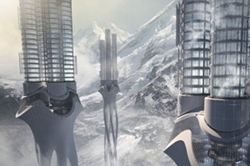
by Brianna Crandall — March 16, 2012—eVolo Magazine has announced the imaginative winners of its 2012 Skyscraper Competition. Established in 2006, the annual Skyscraper Competition recognizes outstanding ideas that redefine skyscraper design through the use of new technologies, materials, programs, aesthetics, and spatial organizations, along with studies on globalization, flexibility, adaptability, and the digital revolution.
The competition also investigates the dynamics of public and private space, and the role of the individual and the collective in the creation of a dynamic and adaptive vertical community. The award seeks to discover young talent, whose ideas will change the way we understand architecture and its relationship with the natural and built environments, say the organizers.
The jury of the 2012 edition, comprised of leaders of the architecture and design fields, selected three winners and 22 honorable mentions. eVolo Magazine received 714 projects from all five continents and 95 different countries.
First place was awarded to Zhi Zheng, Hongchuan Zhao and Dongbai Song from China for their project “Himalaya Water Tower.” They designed a skyscraper located in the heights of the Himalayan mountain range that stores water and helps regulate its dispersal to the land below as the mountains’ natural supplies dry up, thus helping to offset the irregular flow of the region’s rivers due to the seasons. The skyscraper, which can be replicated en masse, will collect water in the rainy season, purify it, freeze it into ice, and store it for future use.

Placing second were Yiting Shen, Nanjue Wang, Ji Xia, and Zihan Wang from China for their project “Mountain Band-Aid,” a proposal that seeks to simultaneously return the displaced Hmong mountain people to their homes and work as farmers and to restore the ecology of the Yunnan mountain range in the wake of extensive mining.
The recipient of the third place is Lin Yu-Ta from Taiwan for a “Monument to Civilization: Vertical Landfill for Metropolises” to be located in the largest cities around the globe, both as a reminder of the outrageous amount of garbage that we produce and as a power plant that harvests energy from waste decomposition.
Among the honorable mentions there are underwater projects for ocean research, mobile skyscrapers, floating cities, and temporal buildings that attach to existing structures, all offering an exciting view of the world to come.




